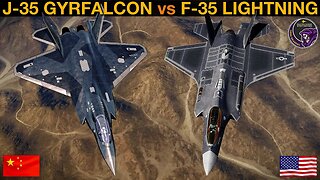J 20 ‘Mighty Dragon’ Vs F 22 ‘Raptor’ #f22 #j20 #usmilitary #chinamilitary
After China employed its fifth-generation J-20 stealth fighter for the first time in the ongoing live fire drills, it could lock horns with one of its prime contenders in the US Air Force (USAF) arsenal – the F-22 Raptor. The other is the F-35 Lightning II.
Officials reported that the US used a dozen F-22s and four F-35s in exercises with Japan. It was in response to growing Russian and Chinese “strategic coordination military flights” over the Sea of Japan and other naval maneuvers.
Developed by Lockheed Martin, the Raptor came into service in 1997, with the final delivery in 2012, with around 187. It is a pure, full-stealth air dominance fighter with little ground attack capability, which the USAF found poorly needed around 2009.
This was during the height of the US’ global war on terror, where there were no air-to-air missions. The USAF then briefly toyed with retiring the jet but retained it after seeing the J-20s entry.
The F-22 is smaller at 62 feet and has pitch-directional thrust-vectoring Pratt and Whitney F-119-100 engines with rectangular slits as exhausts.
They can push it to Mach 2 speeds (2,469 km/hour), fly for 799 kilometers without external fuel drop, and 2,962 kilometers with refueling while reaching a maximum service ceiling of 50,000 feet.
The Pratt and Whitney engines are some of the best in the world that give the Raptor super-cruise capability, where it can reach supersonic speeds without engaging afterburners. This expends less fuel and reduces infrared signature, which enemy airborne, ground-based, and missile sensors cannot detect.
====================================
We appreciate all of our viewers and supporters. Thank you.
====================================
Support us on Patreon: https://www.patreon.com/shieldwalldefense
====================================
Fair use is the right to use a copyrighted work under certain conditions without permission of the copyright owner. The doctrine helps prevent a rigid application of copyright law that would stifle the very creativity the law is designed to foster. It allows one to use and build upon prior works in a manner that does not unfairly deprive prior copyright owners of the right to control and benefit from their works. Together with other features of copyright law like the idea/expression dichotomy discussed above, fair use reconciles the copyright statute with the First Amendment.
====================================
-
 7:23
7:23
US Military News
4 years agoChina’s J-20 vs American F-22 Raptor: Which One is Better?
20 -
 5:49
5:49
lmerika0609trops
1 year agoChina’s J-20 Stealth Fighter: A Threat Or A Flying ‘Paper Tiger’?
164 -
 7:35
7:35
American Military News
1 year agoUS F-22 Raptor fighter jet in action
6042 -
 29:21
29:21
Grim Reapers
10 months agoF-35C Squadron vs *NEW* J-35 Gyrfalcon Squadron (5th Gen Naval Battle 107) | DCS
164 -
 39:27
39:27
Grim Reapers
1 year agoC-17 With Rapid Dragon vs Entire IJN Pearl Harbor Carrier Group (WarGames 127) | DCS
9857 -
 47:56
47:56
Grim Reapers
11 months agoMass Battle: The US Air Force vs The Chinese Air Force & Navy (WarGames 150) | DCS
5922 -
 0:51
0:51
Mr
11 months agoDramatic Air Duel: US Intercepts Chinese Jet
33 -
 19:58
19:58
Grim Reapers
10 months agoIMPROVED F-22 Raptor vs Su-57 Felon: 5th Gen Dogfight | DCS
87 -
 28:14
28:14
Grim Reapers
10 months agoJ-35 Gyrfalcon vs F-35A Lightning II: 5th Gen BVR Battle & Dogfight | DCS
3811 -
 2:29
2:29
Military Modeling
1 year agoLockheed Martin F-16 B/M Fighting Falcon
17